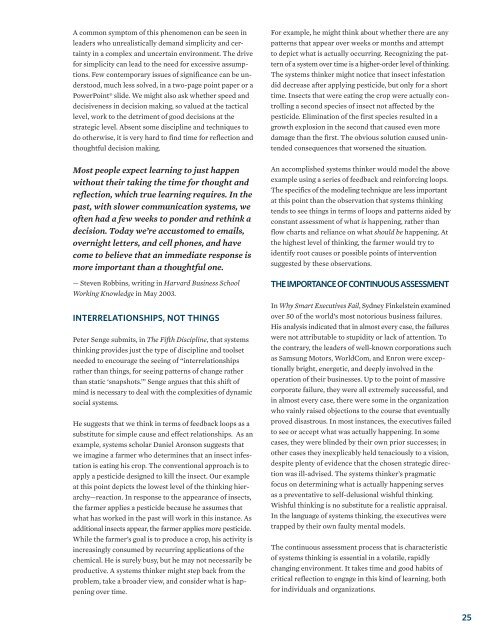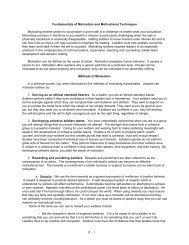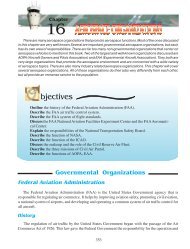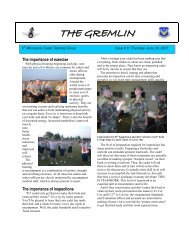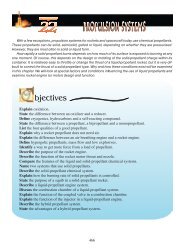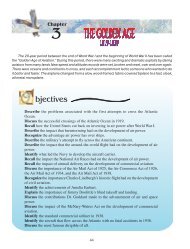thinking about organizations. She makes a point worthyof repeating: The use of lower level models is problematicwhen applied to higher level systems. Thus, the languageof simple machines creates blind spots when used as ametaphor for human or social systems; human systemsare infinitely more complex and dynamic. In other words,it can be counterproductive to treat a complex dynamicsocial system like a simple machine.Noted management scholar Russell Ackoff puts it anotherway. He asserts that we are in the process of leaving themachine age that had roots in the Renaissance and cameinto favor through the industrialization of society. In thatera the machine metaphor became the predominant wayof looking at organizations. The universe was envisionedby thinkers such as Isaac Newton, as having the characteristicsof a big clock. The workings of the clock could beunderstood through the process of analysis and the analyticalmethod.Analysis involves taking apart something of interest,trying to understand the behavior of its parts, and thenassembling the understanding of the parts into an understandingof the whole. According to Ackoff, “One simplerelationship—cause and effect—was sufficient to explainall relationships.” Much machine-age thinking remainswith us today; however, there are alternatives.SYSTEMS THINKINGSystems, like the human body, have parts, and the partsaffect the performance of the whole. All of the parts areinterdependent. The liver interacts with and affects otherinternal organs—the brain, heart, kidneys, etc. You canstudy the parts singly, but because of the interactions, itdoesn’t make much practical sense to stop there. Understandingof the system cannot depend on analysis alone.The key to understanding is, therefore, synthesis. Thesystems approach is to:• Identify a system. After all, not all things are systems.Some systems are simple and predictable, while othersare complex and dynamic. Most human social systems arethe latter.• Explain the behavior or properties of the whole system.This focus on the whole is the process of synthesis.Ackoff says that analysis looks into things while synthesislooks out of things.• Explain the behavior or properties of the thing to beexplained in terms of the role(s) or function(s) of thewhole.The systems thinker retains focus on the system as awhole, and the analysis in step three (the third bullet) isalways in terms of the overall purpose of the system.Borrowing Ackoff’s approach and using the example of acontemporary defense issue might help clarify what isadmittedly abstract at first glance.Consider the Institute for Defense Analyses report TransformingDoD Management: the Systems Approach. Theauthors of this study suggested an alternative approach toService-based readiness reporting, one that consideredthe entire defense transportation system. One section ofthe report suggests that knowing the status of equipment,training, and manning of transportation units is helpfulbut insufficient to determine the readiness of a systemthat includes elements such as airfields, road networks,ships, and ports. The defense transportation systemincludes elements of all Services and even some commercialentities. It only makes sense, therefore, to assess readinessof these elements as part of a larger system that hasan identifiable purpose—to move personnel and materielto the right place at the right time. In this example youcan clearly see the approach recommended by Ackoff.THE PROBLEM OF BUSYNESSFew would disagree, in principle, that senior leadersshould see not only the parts, but also the big picture. Sowhy don’t we do more of it? One reason is because we areso darned busy. Immersed in the myriad details of dailyexistence, it is easy to lose sight of the bigger picture.While it may be important to orient on values, goals, andobjectives, the urgent often displaces the important.Fighting off the alligators inevitably takes precedenceover draining the swamp.The problem of busyness can be compounded by seniorleaders who are overscheduled and uneducated in systemsthinking. It seems as though military officers today workexcessive hours as a matter of pride. A cursory examinationof the calendar of most contemporary officers, especiallyflag officers, will indicate an abusive pace. Consideras an alternative the example of one of America’s greatestsoldier-statesmen, Gen. George C. Marshall. Even at theheight of World War II, Marshall typically rode a horse inthe morning for exercise, came home for lunch and visitedwith his wife, went to bed early, and regularly took retreatsto rejuvenate. To what extent are such pauses for reflectionand renewal valued today? Simple cause and effectthinking combined with a culture of busyness can resultin decision makers who rapid-fire short-term solutions atlong-term problems without taking time to think aboutthe actual impact of those solutions.24
A common symptom of this phenomenon can be seen inleaders who unrealistically demand simplicity and certaintyin a complex and uncertain environment. The drivefor simplicity can lead to the need for excessive assumptions.Few contemporary issues of significance can be understood,much less solved, in a two-page point paper or aPowerPoint® slide. We might also ask whether speed anddecisiveness in decision making, so valued at the tacticallevel, work to the detriment of good decisions at thestrategic level. Absent some discipline and techniques todo otherwise, it is very hard to find time for reflection andthoughtful decision making.Most people expect learning to just happenwithout their taking the time for thought andreflection, which true learning requires. In thepast, with slower communication systems, weoften had a few weeks to ponder and rethink adecision. Today we’re accustomed to emails,overnight letters, and cell phones, and havecome to believe that an immediate response ismore important than a thoughtful one.— Steven Robbins, writing in Harvard Business SchoolWorking Knowledge in May 2003.INTERRELATIONSHIPS, NOT THINGSPeter Senge submits, in The Fifth Discipline, that systemsthinking provides just the type of discipline and toolsetneeded to encourage the seeing of “interrelationshipsrather than things, for seeing patterns of change ratherthan static ‘snapshots.’” Senge argues that this shift ofmind is necessary to deal with the complexities of dynamicsocial systems.He suggests that we think in terms of feedback loops as asubstitute for simple cause and effect relationships. As anexample, systems scholar Daniel Aronson suggests thatwe imagine a farmer who determines that an insect infestationis eating his crop. The conventional approach is toapply a pesticide designed to kill the insect. Our exampleat this point depicts the lowest level of the thinking hierarchy—reaction.In response to the appearance of insects,the farmer applies a pesticide because he assumes thatwhat has worked in the past will work in this instance. Asadditional insects appear, the farmer applies more pesticide.While the farmer’s goal is to produce a crop, his activity isincreasingly consumed by recurring applications of thechemical. He is surely busy, but he may not necessarily beproductive. A systems thinker might step back from theproblem, take a broader view, and consider what is happeningover time.For example, he might think about whether there are anypatterns that appear over weeks or months and attemptto depict what is actually occurring. Recognizing the patternof a system over time is a higher-order level of thinking.The systems thinker might notice that insect infestationdid decrease after applying pesticide, but only for a shorttime. Insects that were eating the crop were actually controllinga second species of insect not affected by thepesticide. Elimination of the first species resulted in agrowth explosion in the second that caused even moredamage than the first. The obvious solution caused unintendedconsequences that worsened the situation.An accomplished systems thinker would model the aboveexample using a series of feedback and reinforcing loops.The specifics of the modeling technique are less importantat this point than the observation that systems thinkingtends to see things in terms of loops and patterns aided byconstant assessment of what is happening, rather thanflow charts and reliance on what should be happening. Atthe highest level of thinking, the farmer would try toidentify root causes or possible points of interventionsuggested by these observations.THE IMPORTANCE OF CONTINUOUS ASSESSMENTIn Why Smart Executives Fail, Sydney Finkelstein examinedover 50 of the world’s most notorious business failures.His analysis indicated that in almost every case, the failureswere not attributable to stupidity or lack of attention. Tothe contrary, the leaders of well-known corporations suchas Samsung Motors, WorldCom, and Enron were exceptionallybright, energetic, and deeply involved in theoperation of their businesses. Up to the point of massivecorporate failure, they were all extremely successful, andin almost every case, there were some in the organizationwho vainly raised objections to the course that eventuallyproved disastrous. In most instances, the executives failedto see or accept what was actually happening. In somecases, they were blinded by their own prior successes; inother cases they inexplicably held tenaciously to a vision,despite plenty of evidence that the chosen strategic directionwas ill-advised. The systems thinker’s pragmaticfocus on determining what is actually happening servesas a preventative to self-delusional wishful thinking.Wishful thinking is no substitute for a realistic appraisal.In the language of systems thinking, the executives weretrapped by their own faulty mental models.The continuous assessment process that is characteristicof systems thinking is essential in a volatile, rapidlychanging environment. It takes time and good habits ofcritical reflection to engage in this kind of learning, bothfor individuals and organizations.25
- Page 1 and 2: VOLUME FOUR STRATEGIC PERSPECTIVESL
- Page 3 and 4: VOLUME FOUR STRATEGIC PERSPECTIVESL
- Page 5 and 6: VOLUME FOUR STRATEGIC PERSPECTIVESL
- Page 7: VOLUME FOUR STRATEGIC PERSPECTIVESL
- Page 10 and 11: 12CHAPTER 12INTRODUCTION TO STRATEG
- Page 12 and 13: 12.1 Strategic Leadership: Defining
- Page 14 and 15: mandates or resolutions that would
- Page 16 and 17: and ambiguity, aspiring strategic l
- Page 18 and 19: 12.2 National Security StrategyThe
- Page 20 and 21: within our borders has always been
- Page 22 and 23: front common challenges like violen
- Page 24 and 25: and our strategy, not sector earmar
- Page 28 and 29: A systemic approach to failure is m
- Page 30 and 31: The late W. T. Grant Company is a r
- Page 32 and 33: the resources - setting the directi
- Page 34 and 35: focal point for describing and inte
- Page 36 and 37: Consequently, we do not restrict th
- Page 38 and 39: paragraphs, Web pages, then edit an
- Page 40 and 41: Web, can be viewed as a CS attempt
- Page 42 and 43: How to evaluate users and contribut
- Page 44 and 45: 13CHAPTER 13LEADING PUBLIC &VOLUNTE
- Page 46 and 47: 13.1 Leadership for Volunteers:The
- Page 48 and 49: 13.2 Take Root: Volunteer Managemen
- Page 50 and 51: QualificationsClearly list educatio
- Page 52 and 53: and effectively track their volunte
- Page 54 and 55: • Understand rules for recognitio
- Page 56 and 57: • Send a birthday card.• Submit
- Page 58 and 59: and tested more than six decades af
- Page 60 and 61: specific interests of the donors, v
- Page 62 and 63: tain) tax-exempt status from the In
- Page 64 and 65: Smucker, 1999).The Internal Revenue
- Page 66 and 67: culture is necessary to ensure the
- Page 68 and 69: 13.4 The New Look of TransparencyBy
- Page 70 and 71: ees for a couple of reasons: One, i
- Page 72 and 73: 13.5 Public and Private Management:
- Page 74 and 75: TABLE 1:FUNCTIONS OF GENERAL MANAGE
- Page 76 and 77:
3. Career System. The model corpora
- Page 78 and 79:
islative charter - the Clean Air Ac
- Page 80 and 81:
In controlling performance, Chapin
- Page 82 and 83:
14CHAPTER 14AIRPOWER ASSTRATEGIC LA
- Page 84 and 85:
14.1 Strategic Air Power: Fulfillme
- Page 86 and 87:
carry it out. Their daylight raids
- Page 88 and 89:
you did not rely on strategic bombi
- Page 90 and 91:
14.2 Warden and the Air Corps Tacti
- Page 92 and 93:
ecomes one of applying sufficient i
- Page 94 and 95:
tification, and a Jominian claim to
- Page 96 and 97:
courage the rapid and widespread ex
- Page 98 and 99:
it to influence physical players in
- Page 100 and 101:
14.4 Basic Air Force DoctrineAF Doc
- Page 102 and 103:
earthquake-stricken Haiti. The worl
- Page 104 and 105:
perspective. Airmen do not divide u
- Page 106 and 107:
Command and ControlCommand and cont
- Page 108 and 109:
14.5 Should the US Maintain the Nuc
- Page 110 and 111:
form of human government.” 20 Dem
- Page 112 and 113:
obtainable goal. See the Global Zer
- Page 114 and 115:
15CHAPTER 15ORGANIZATIONAL CULTURE
- Page 116 and 117:
15.1 Organizational CultureBy Doria
- Page 118 and 119:
Review. This action strives to unco
- Page 120 and 121:
gram will serve and then having the
- Page 122 and 123:
ticipating the changes being made b
- Page 124 and 125:
Many years of working with change p
- Page 126 and 127:
At the least, the areas of concern
- Page 128 and 129:
15.4 Developing an Innovative Cultu
- Page 130 and 131:
CONCLUDING THOUGHTSIn an ever-chang
- Page 132 and 133:
global issues. Businesses that poss
- Page 134 and 135:
— Sees the big picture—the shif
- Page 136 and 137:
16CHAPTER 16STRATEGIC COMMUNICATION
- Page 138 and 139:
16.1 Principles of Strategic Commun
- Page 140 and 141:
16.2 The Art of NegotiationBy Brend
- Page 142 and 143:
16.3 Negotiating Effectively Across
- Page 144 and 145:
hidden areas can act as cultural ho
- Page 146 and 147:
and four conflict styles. Hammer be
- Page 148 and 149:
maintaining the relationship. As th
- Page 150 and 151:
25 Mitchell R. Hammer, “Chapter 1
- Page 152 and 153:
tural, socioeconomic, and psycholog
- Page 154 and 155:
for the win-win," during which time
- Page 156 and 157:
interests and, at worst, as a gun s
- Page 158 and 159:
Public diplomacy is surely about mu
- Page 160 and 161:
But public diplomats do not have th
- Page 162 and 163:
Photo courtesy of the familyThe LEA
- Page 164:
THE CADET OATHI pledge that I will


